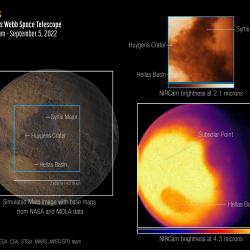Encyclopédie
Sulphuric acid rain showers on Venus never reach the surface of the planet due to evaporation.
A filter that selects different optical wavelengths in an incoming light beam by applying a radio-frequency signal.
A multidisciplinary science based on observations of the atmospherical environment (terrestrial and extraterrestrial).
Large cities, as well as the main industrial regions stand out as severely polluted and are consequently clearly identifiable on air pollution maps.
Atmospheres of planets glow constantly during both day and night as sunlight interacts with atoms and molecules.
1992 mission with experiments for understanding the interaction between the sun and the Earth's atmosphere. Belgian astronaut Dirk Frimout flew along.
Gases in Earth’s atmosphere (like nitrogen, oxygen and ozone) filter out harmful UV radiation
The colour of polar lights (or auroras) teaches us something about the chemical elements in our atmosphere.
Blue, green, red. Twisting, diffuse or curtain-like… Auroras occur when the Earth’s magnetosphere traps or diverts the charged particles from the Sun.
Auroral activity occurs in oval-shaped regions centered at the two geomagnetic poles.

